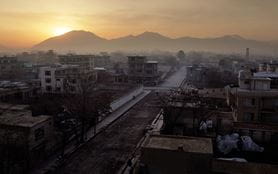The impact of A&O’s partnership with War Child two years on
Related people
Headlines in this article
Related news and insights
News: 10 October 2022
Hope and Homes for Children secures major breakthrough in mission to close all orphanages
News: 03 October 2022
News: 20 September 2022
Charities in Northern Ireland benefit from Allen & Overy Foundation
News: 13 July 2022

In fundraising terms, it was the firm's most successful partnership, raising GBP1.5m and breaking all previous fundraising records. It generated the template for a more sustainable form of funding for global charity partners and – most importantly – supported thousands of families affected by conflict in the Middle East and Africa.
“I remember the bell in our London office ringing to announce that we'd won the vote to be A&O's new charity partner,” says Rob Williams, War Child's CEO.
The bell, donated by colleagues in Jordan, is rung every time the charity receives some good news. "Back then, I had no idea just how significant the news would turn out to be. I knew the partnership would be transformational for the Syrian children we wanted to support – but I didn’t know it would become the biggest corporate partnership in our history,” Rob says.
The partnership takes off
In 2016, the focus of A&O's global charity partnership shifted from providing access to education – as with previous partners AfriKids and Amref Health Africa – to addressing the plight of displaced people.
“The global refugee crisis was a politically sensitive issue," senior partner Wim Dejonghe says, "with millions of people displaced as a result of religious intolerance or political nationalism. Yet it wasn't an issue we could turn away from. We felt with our resources we could make an impact so long as we chose a good organisation to work with – which we certainly did with War Child."
The escalating refugee crisis had clearly struck a chord across A&O, says Singapore partner Brendan Hannigan who was involved with the partnership throughout.
"The figures were – still are – shocking," he says. By the middle of 2017, the UN refugee agency (UNHCR) was reporting that some 66 million people had been displaced by conflict around the world, including 5.5 million from Syria alone.
The response across A&O was amazing, Brendan says. Nearly 2,500 people took part in the staff vote and more than 600 signed up to volunteer with fundraising and pro bono efforts. “Given what War Child was setting out to achieve, the partnership had real momentum from the outset,” he says.
Nick Scott, the charity’s former Head of Partnerships, agrees. "The opportunities it presented for War Child were huge," he says. "When you're talking about a global business with significant resources across 31 countries, we felt we could achieve something really powerful together."
Rescuing Syrian childhoods
Initially the partnership had a target of raising GBP500,000 to fund a specific education project, Rescue Childhood, in the Emirati refugee camp in Jordan.
The Emirati camp was new and well-built but had relatively little infrastructure and provision for the thousands of women and children living there.
“Za’atari – a bigger camp in Jordan – is a like a small city,” Nick says. “There are employment opportunities, a functioning education system and all sorts of shops. Emirati, by contrast, had much less, certainly no education system. That’s why we wanted to go in there.”
Rescue Childhood was designed to provide psychosocial support and education for young children displaced by the Syrian conflict. Its aim was to deliver a system of Early Childhood Care and Development (ECCD) for around 2,000 children, and to support parents and caregivers to achieve a more joined up approach between the classroom and home.
The need for the programme was clear. Interruptions to children’s early education and development were having a significant impact on their ability to succeed at school. Children were not only returning to education at very different stages of development, but often displayed the symptoms of deep trauma, such as nightmares, poor concentration, an inability to form relationships and even violent or antisocial behaviour.
The response to our first fundraising campaign in January 2017 was enormous. It raised GBP467,000 – our most successful campaign ever.
Wim Dejonghe
A record effort
"The stories of the Syrian families War Child was helping really showed us the human dimension of the refugee crisis," Wim says.
"The response to our first fundraising campaign in January 2017 was enormous. It raised GBP467,000 – our most successful campaign ever."
This combined with other events meant that just six months into the partnership the initial fundraising target was exceeded. A new GBP1m target was announced, which was also broken six months later.
The impact of this was felt quickly in the Emirati camp. Over the course of the project, War Child provided education, recreation and psychosocial support to over 2,200 children, as well as 800 parents and caregivers (more than four times the initial target) meaning that with an average family size of five, the programme has reached an estimated 4,200 children.
Sustainable funding
The early success of the partnership meant that the additional money raised could be provided on unrestricted terms, allowing War Child to invest it at its own discretion and help sustain its work long after the relationship with A&O ended.
As Brendan explains: “The idea of unrestricted funding – not having direct input on what our money funds – can be tricky to engage people with internally, particularly when the sums involved are substantial.
“But War Child was unlikely to have another partner step in and replace us immediately, so rather than have a sudden loss in funding, this allowed it to build a financial buffer. Conflicts can also spring up or escalate quickly, so it also provided fast access to emergency funds.”
By investing just over 20% of unrestricted funding in its internal operations, War Child created important new funding streams, one of which has been to grow its gaming team to develop new ways of attracting donations. An example is the award-winning Armistice initiative, where, for Remembrance Day, gaming studios are asked to pacify their games for a short period and set up a donation function.
As Nick puts it: “The gaming function is starting to influence the rest of the team, demonstrating how mass-market fundraising can work. Our revenue from gaming is nearly five times higher now than it was in 2016. We wouldn’t have achieved that without the unrestricted funding from A&O – overall, it has enabled us to bring in at least an extra GBP900,000.”
“If all our funding had to be directed towards specific projects, there would be no life for things like the Rescue Childhood programme after the partnership with A&O ended. We wouldn’t be talking about what we’ve learnt and how we are replicating the project in other countries," Nick says. "The legacy piece is everything.”

Learning from War Child
Brendan believes A&O has learnt much from War Child, too. For him, the highpoint was visiting the KATI project in northern Uganda – a social venture set up by War Child in 2013 and scaled up to become an independent, youth-led organisation that supports a generation still living with the devastation caused by the 20-year conflict.
Through KATI, War Child has worked with local communities to brainstorm business ideas, provide seed funding and offer ongoing mentoring for young entrepreneurs to set up microbusinesses.
"The young people are incredible," Brendan says. "They have buckets of energy and loads of ideas. It shows we don’t need to come in with capes flying and 'save them' – they just need some initial support and can do the rest themselves."
The trip changed his view of Africa completely. “Within a few hours of arriving in Uganda, every single assumption I had was turned on its head," says Brendan. "I was so impressed by the local team and the young people themselves. I came away feeling massively positive."
Important pro bono support
For Nick, a standout feature of the partnership was the strength and imagination of A&O's pro bono and community investment team who, he says, were professional and demanding – in a good way.
The largest single pro bono project was a review of War Child's safeguarding procedures in the wake of allegations of sexual exploitation that rocked the international charity sector in 2018. War Child was in no way associated with any of those allegations but nonetheless asked A&O to undertake a large scale culture and operations review to ensure its practices continued to meet the highest standards.
Overall, nearly every office contributed to the partnership through pro bono, global fundraising campaigns and over 100 fundraising events – including two 70km treks across the Dana Nature Reserve in Jordan to the ancient city of Petra.
Longevity
The impact of the partnership has been felt most by the Syrian families in Jordan. The longevity of the partnership, as Wim says, has been the most important feature, with the benefits he saw so clearly on his visits to Emirati camp being sustained well after the end of the formal partnership.
“By raising more than we ever thought possible, we've been able to help thousands of children caught up in conflict – not just while the relationship lasted but way into the future,” Wim says. “That is the result we always hoped for.”



